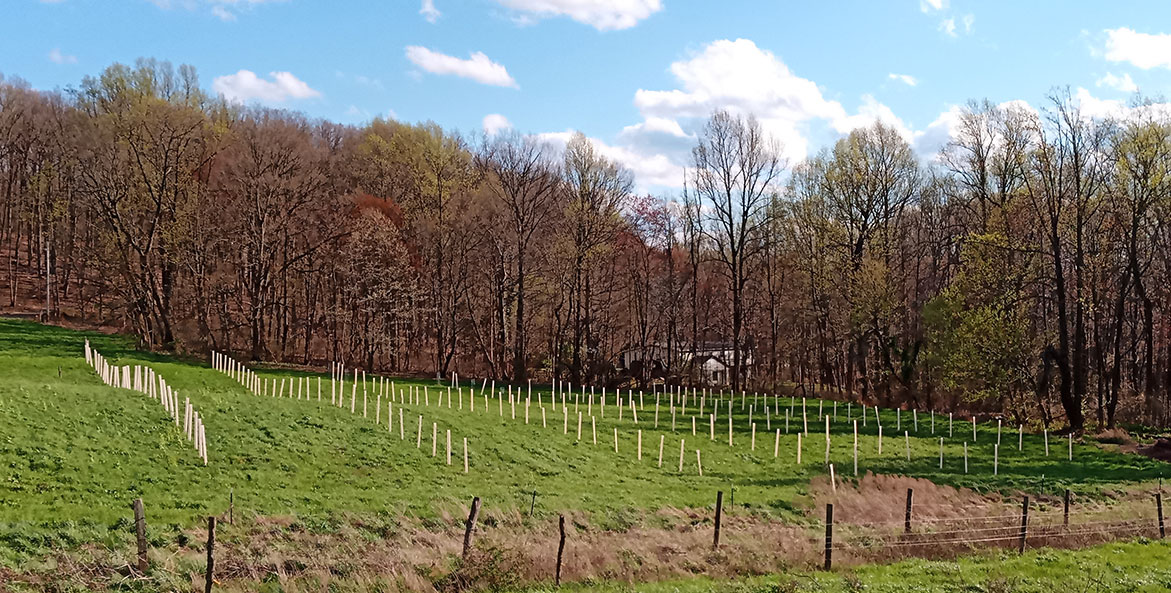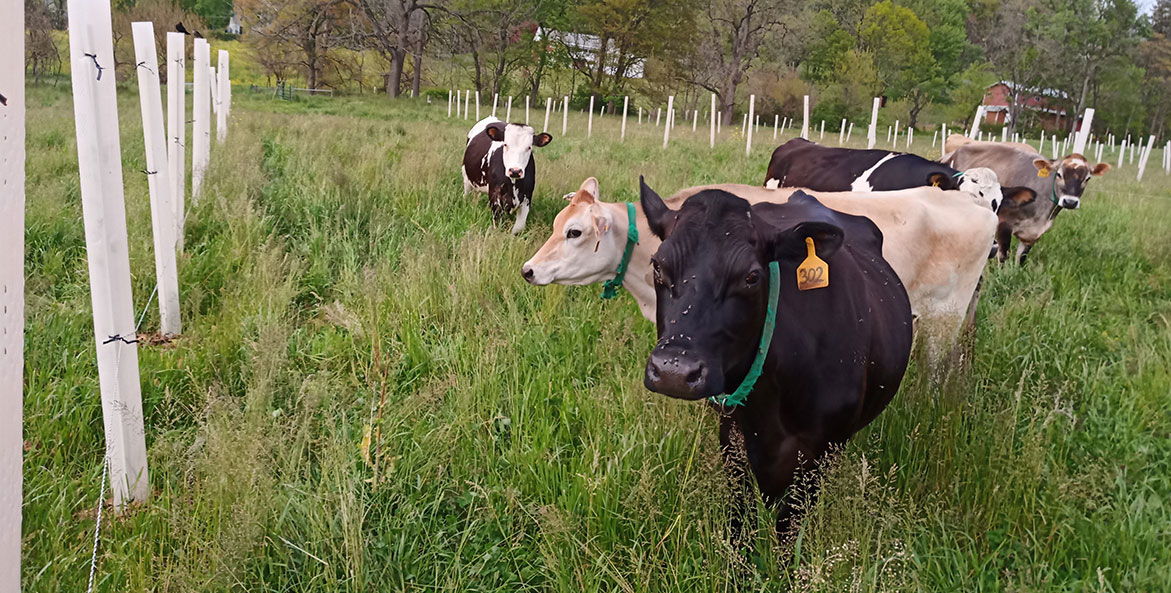Silvopasture—the intentional integration of trees and grazing livestock on the same land—has been around longer than the industrialization of farming and carries many economic and environmental benefits. But it isn’t easy. A new study, led by CBF and supported by a three-year grant from the Northeast Sustainable Agriculture Research and Education Program Research under the U.S. Department of Agriculture, on five Pennsylvania farms is exploring how farmers can implement silvopasture cost-effectively and successfully.
“It adds complexity to your system, but there could be some serious benefits long-term, especially economic,” says Molly Cheatum, CBF Restoration Program Manager in Pennsylvania and the study leader. “You get healthier soils, grasses, and trees. You are also reducing polluted runoff and sequestering carbon.”
When planted and matured in a pasture, trees can enhance herd health by offering shade, shelter, better quality grazing, and reduced stress on livestock, especially during summer’s relentless heat. Livestock can return the favor. “If you have trees, healthy grasses, and cattle roaming through a pasture, they are providing manure that feeds the soil and the trees,” Cheatum says.
The study will look to guide farmers on how to get productive trees established in active pastures given predation, livestock damage, limited resources, and different types and quality of forage and soils.
Silvopasture research plots of 120 trees have been planted on three farms in Lancaster County and two in Lebanon County. Trees planted were honey locust, black locust, persimmon, willow, poplar, mulberry, redbud, and tulip poplar.
The study is monitoring tree planting techniques with and without mulch, plastic and metal shelters, and live stake trees in combinations with electric fence, barbed wire, and no shelters.

A silvopasture planting on a farm in Lancaster County, PA.
Austin Unruh
Fiddle Creek Dairy Farm in Quarryville, Lancaster County was the first farm to get trees for the study and planted 1,500, including the 120 for the research. There are nine cows and seven heifers on the farm that produces yogurt, other dairy products, and beef.
“When the cows get to the tubes, it’s like a great big toy, a scratching post,” dairy owner Tim Sauder says. “There was one time we switched our grazing time and gave them a section and overnight they knocked four or five tubes down. You could tell they were having fun.”
The cows have access to all 1,500 trees, and although not within the study’s 120-tree section, the experience sheds light onto livestock interaction with trees. Sauder also knows that six-foot tubes are most effective. “Trees that have five-foot tubes are being munched on soon as leaves appear,” he says.
CBF is keenly interested in silvopasture because of the Keystone 10 Million Trees Partnership. The Partnership, coordinated by CBF, intends to plant 10 million trees in the Commonwealth by the end of 2025.
Trees are among the most cost-effective methods for filtering and absorbing harmful polluted runoff, especially from agriculture. That makes silvopasture a first line of defense against pollution for waters like the unnamed tributary of Big Beaver Creek that runs through the Sauders’ farm.
“If we are talking about water management, it is best to keep your water high,” Cheatum adds. “An added benefit to planting trees in pasture, if upslope from a stream, is the spreading and slowing of water through the landscape. Which means any practices downslope may not have to work so hard to filter nutrients.”
The study investigates how best to incorporate and protect trees in the pasture without disrupting farming operations and profitability. “We want to be able to integrate trees thoughtfully onto a farm, but we want the farm not to have to drastically change the way that they practice their grazing,” says project partner Austin Unruh. He owns Crow & Berry Land Management in Lancaster County and has worked directly with farmers involved in the study.
The study will also track costs of site preparation, seedlings, planting labor, and materials like fencing, metal and plastic shelters, and mulch so that farmers can decide on the best approach for their own properties.
Tim Sauder is inspired by the prospects of silvopasture from a tree the grows not in a pasture, but along his driveway. “The best grass on our farm year in and out is one little patch along the driveway underneath the big black walnut tree,” he says. “I cannot wait for five or ten years into this, where this time of year the parts of pasture where there are no trees are usually brown, hot, and dry. A little bit of shade helps those grasses to really thrive. That is what the cows really like.”
This material is based upon work supported by the National Institute of Food and Agriculture, U.S. Department of Agriculture, through the Northeast Sustainable Agriculture Research and Education program under subaward number LNE20-405R.

Issues in this Post
Agriculture Agriculture Keystone Ten Million Trees Partnership Trees CBF in Pennsylvania



